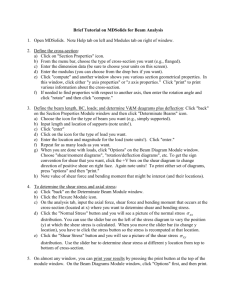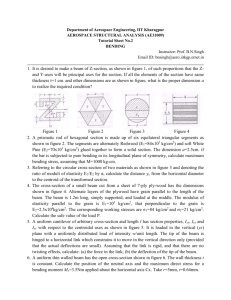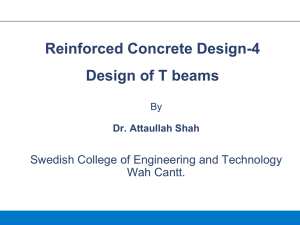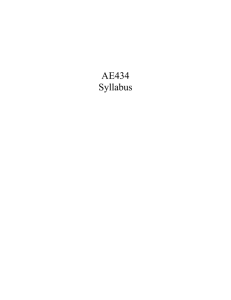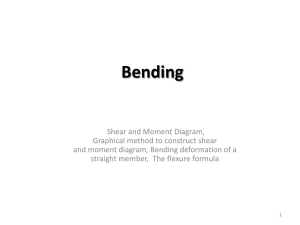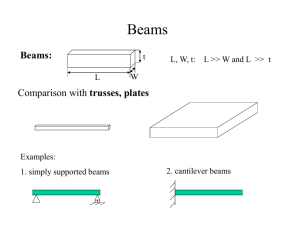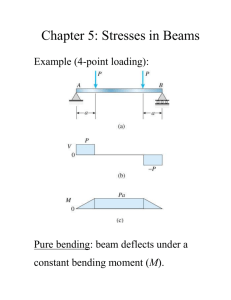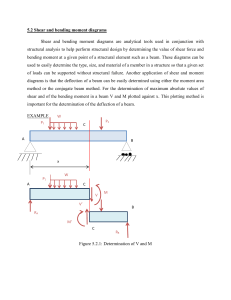stress distribution in typical cross
advertisement
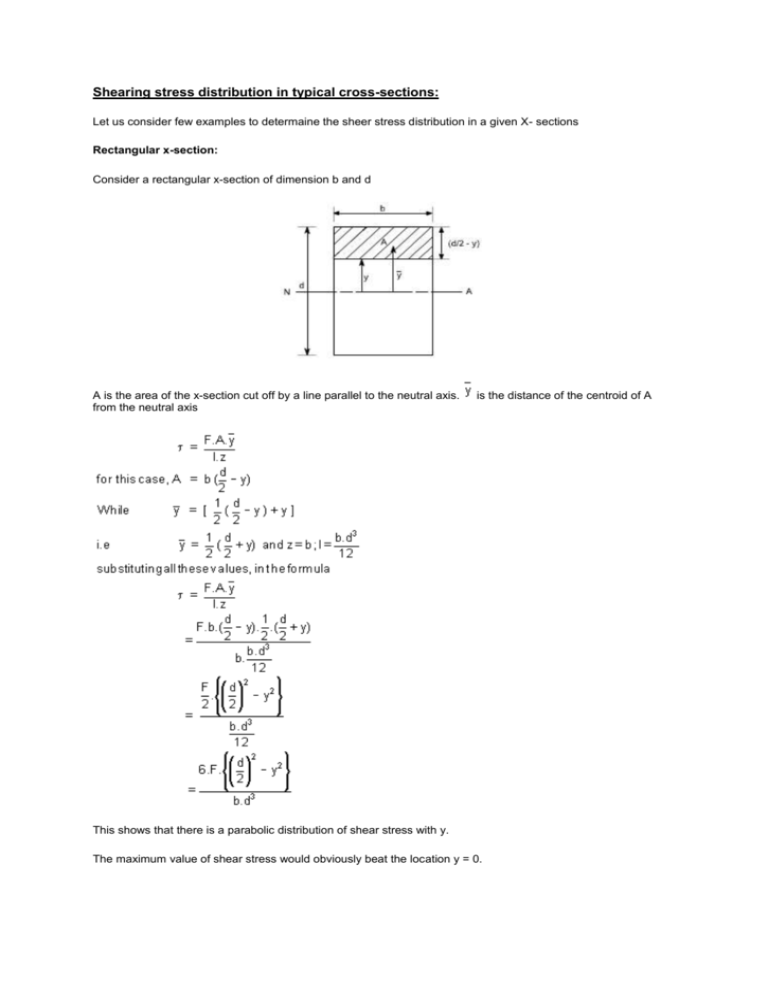
Shearing stress distribution in typical cross-sections: Let us consider few examples to determaine the sheer stress distribution in a given X- sections Rectangular x-section: Consider a rectangular x-section of dimension b and d A is the area of the x-section cut off by a line parallel to the neutral axis. from the neutral axis is the distance of the centroid of A This shows that there is a parabolic distribution of shear stress with y. The maximum value of shear stress would obviously beat the location y = 0. Therefore the shear stress distribution is shown as below. It may be noted that the shear stress is distributed parabolically over a rectangular cross-section, it is maximum at y = 0 and is zero at the extreme ends. I - section : Consider an I - section of the dimension shown below. The shear stress distribution for any arbitrary shape is given as Let us evaluate the quantity web area , the quantity for this case comprise the contribution due to flange area and Flange area Ad by RoboSaver | Close This Ad Web Area To get the maximum and minimum values of substitute in the above relation. y = 0 at N. A. And y = d/2 at the tip. The maximum shear stress is at the neutral axis. i.e. for the condition y = 0 at N. A. Hence, ..........(2) The minimum stress occur at the top of the web, the term bd 2 goes off and shear stress is given by the following expression ............(3) The distribution of shear stress may be drawn as below, which clearly indicates a parabolic distribution Note: from the above distribution we can see that the shear stress at the flanges is not zero, but it has some value, this can be analyzed from equation (1). At the flange tip or flange or web interface y = d/2.Obviously than this will have some constant value and than onwards this will have parabolic distribution. In practice it is usually found that most of shearing stress usually about 95% is carried by the web, and hence the shear stress in the flange is neglible however if we have the concrete analysis i.e. if we analyze the shearing stress in the flange i.e. writing down the expression for shear stress for flange and web separately, we will have this type of variation. This distribution is known as the “top – hat” distribution. Clearly the web bears the most of the shear stress and bending theory we can say that the flange will bear most of the bending stress. Shear stress distribution in beams of circular cross-section: Let us find the shear stress distribution in beams of circular cross-section. In a beam of circular cross-section, the value of Z width depends on y. Using the expression for the determination of shear stresses for any arbitrary shape or a arbitrary section. Where y dA is the area moment of the shaded portion or the first moment of area. Here in this case ‘dA' is to be found out using the Pythagoras theorem The distribution of shear stresses is shown below, which indicates a parabolic distribution Principal Stresses in Beams It becomes clear that the bending stress in beam x is not a principal stress, since at any distance y from the neutral axis; there is a shear stress( or xy we are assuming a plane stress situation) In general the state of stress at a distance y from the neutral axis will be as follows. At some point ‘P' in the beam, the value of bending stresses is given as After substituting the appropriate values in the above expression we may get the inclination of the principal planes. Illustrative examples: Let us study some illustrative examples,pertaining to determination of principal stresses in a beam 1. Find the principal stress at a point A in a uniform rectangular beam 200 mm deep and 100 mm wide, simply supported at each end over a span of 3 m and carrying a uniformly distributed load of 15,000 N/m. Solution: The reaction can be determined by symmetry R1 = R2 = 22,500 N consider any cross-section X-X located at a distance x from the left end. Hence, S. F at XX =22,500 – 15,000 x B.M at XX = 22,500 x – 15,000 x (x/2) = 22,500 x – 15,000 . x2 / 2 Therefore, S. F at X = 1 m = 7,500 N B. M at X = 1 m = 15,000 N Now substituting these values in the principal stress equation, We get 1 = 11.27 MN/m2 2 = - 0.025 MN/m2 Bending Of Composite or Flitched Beams A composite beam is defined as the one which is constructed from a combination of materials. If such a beam is formed by rigidly bolting together two timber joists and a reinforcing steel plate, then it is termed as a flitched beam. The bending theory is valid when a constant value of Young's modulus applies across a section it cannot be used directly to solve the composite-beam problems where two different materials, and therefore different values of E, exists. The method of solution in such a case is to replace one of the materials by an equivalent section of the other. Consider, a beam as shown in figure in which a steel plate is held centrally in an appropriate recess/pocket between two blocks of wood .Here it is convenient to replace the steel by an equivalent area of wood, retaining the same bending strength. i.e. the moment at any section must be the same in the equivalent section as in the original section so that the force at any given dy in the equivalent beam must be equal to that at the strip it replaces. Hence to replace a steel strip by an equivalent wooden strip the thickness must be multiplied by the modular ratio E/E'. The equivalent section is then one of the same materials throughout and the simple bending theory applies. The stress in the wooden part of the original beam is found directly and that in the steel found from the value at the same point in the equivalent material as follows by utilizing the given relations. Stress in steel = modular ratio x stress in equivalent wood The above procedure of course is not limited to the two materials treated above but applies well for any material combination. The wood and steel flitched beam was nearly chosen as a just for the sake of convenience. Assumption In order to analyze the behavior of composite beams, we first make the assumption that the materials are bonded rigidly together so that there can be no relative axial movement between them. This means that all the assumptions, which were valid for homogenous beams are valid except the one assumption that is no longer valid is that the Young's Modulus is the same throughout the beam. The composite beams need not be made up of horizontal layers of materials as in the earlier example. For instance, a beam might have stiffening plates as shown in the figure below. Again, the equivalent beam of the main beam material can be formed by scaling the breadth of the plate material in proportion to modular ratio. Bearing in mind that the strain at any level is same in both materials, the bending stresses in them are in proportion to the Young's modulus.


